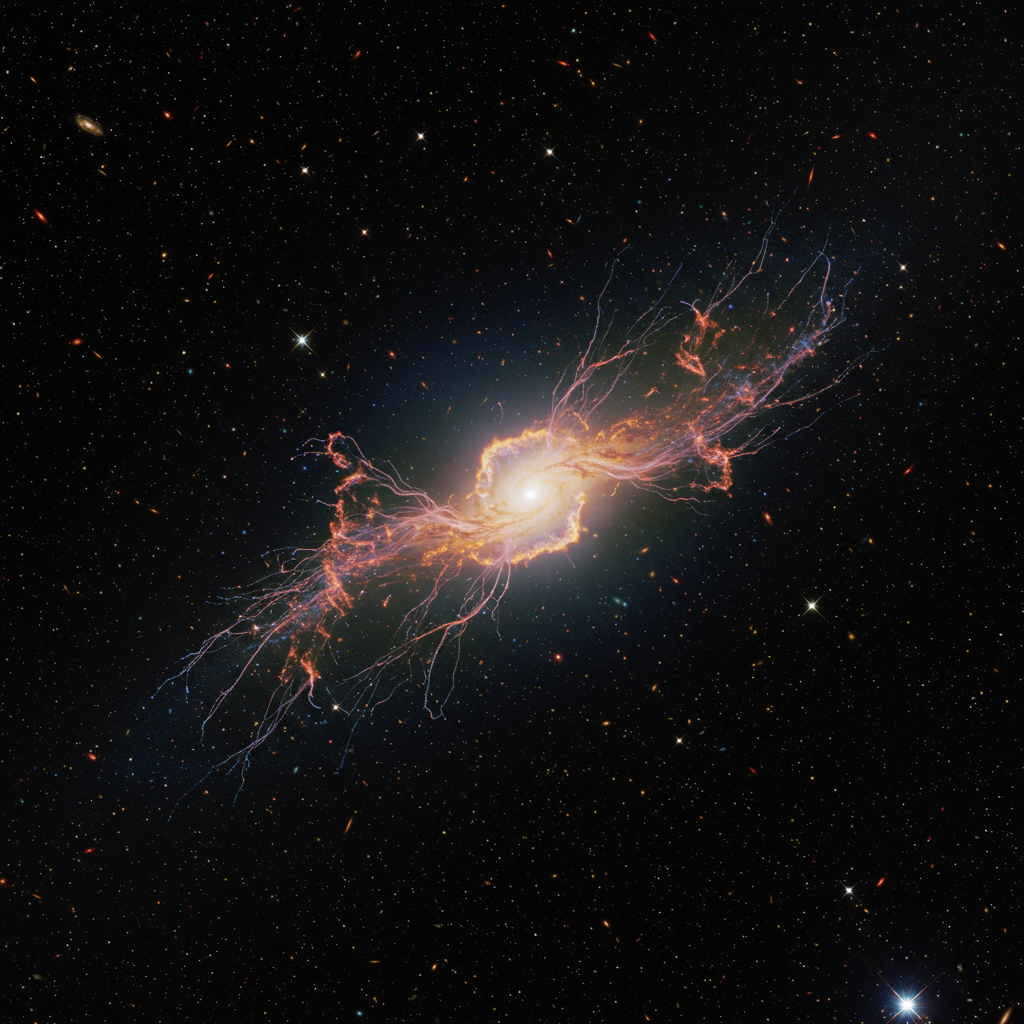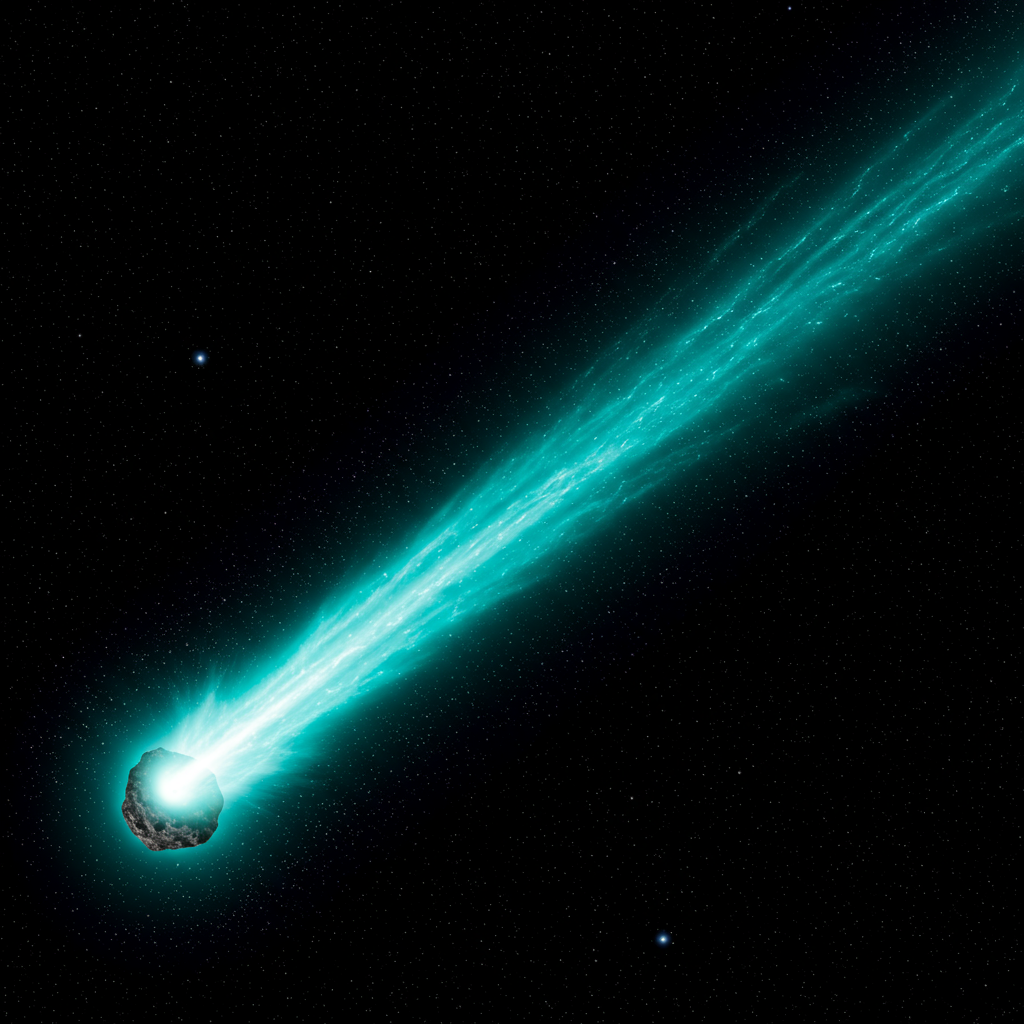Deep space holds countless mysteries, and the James Webb Space Telescope (JWST) continues to peel back the cosmic veil, revealing stunning new phenomena. Astronomers analyzing JWST data have recently spotted what appears to be a remarkably distant galaxy exhibiting striking tentacle-like structures. Nicknamed a “‘jellyfish‘ galaxy” for its unique shape, this potential discovery, located roughly 12 billion light-years away, offers invaluable clues about how galaxies evolve and form stars in the early universe. This find highlights the power of JWST to probe the cosmos at unprecedented distances and resolutions.
James Webb Spots a Cosmic Jellyfish
High-resolution images captured by the James Webb Space Telescope have revealed a galaxy exhibiting unusual tentacle-like trails. These appendages, stretching away from the main body of the galaxy, are composed of gas and stars. This distinctive appearance strongly suggests the galaxy belongs to a class known as jellyfish galaxies.
Jellyfish galaxies are named because they look like celestial jellyfish swimming through space. Their trailing tendrils are key features. More analysis is needed to definitively classify this newfound object. However, initial observations point towards it being one of the most distant jellyfish galaxies ever potentially identified.
Astronomer Ian Roberts at Waterloo University made this intriguing discovery. He found the galaxy while carefully examining images from the JWST. Roberts and his team have shared their research on the preprint server arXiv. It is important to note that their findings have not yet undergone peer review.
Roberts commented on the significance of the find. “The fact that an interesting galaxy such as this one could be found in such a cursory way,” he noted, “suggested that there would be real value in doing a truly systematic search for these sorts of objects.”
What Creates Cosmic Tentacles?
The tentacled appearance of jellyfish galaxies isn’t merely cosmetic. It is the result of a powerful astrophysical process called ram pressure stripping. This phenomenon occurs when a galaxy moves through a dense gaseous environment. Such environments are typically found within galaxy clusters.
As a galaxy travels through the hot, diffuse gas (known as the intracluster medium or ICM) in a cluster, it experiences intense pressure. This pressure is similar to the resistance felt when moving quickly through water or air. The external pressure from the ICM pushes against the galaxy’s own internal gas supply. This strips away some of its gas and even stars. The stripped material then trails behind the galaxy, forming the characteristic tentacles.
These trailing tendrils of stripped material can sometimes become sites of vigorous star formation. Gas compressed within the tentacles can cool and collapse, triggering the birth of new stars far from the galaxy’s core. While ram pressure stripping is a common process in the local universe, catching a galaxy specifically in the “jellyfish” phase is relatively rare on a cosmic timescale. This phase is transient as the stripping process evolves.
A Closer Look at Jellyfish Galaxies
Studying jellyfish galaxies like the one spotted by JWST provides critical insights into galaxy evolution and star formation processes. Galaxies in dense environments, like clusters, behave differently from isolated ones. Many cluster galaxies form fewer new stars compared to their counterparts in less crowded cosmic neighborhoods. Understanding why this happens is fundamental to grasping how galaxies change over billions of years.
Ram pressure stripping significantly impacts star formation within a galaxy. While new stars might burst into existence within the stripped tentacles, the loss of gas from the galaxy’s central region can inhibit or even halt star formation there. This dynamic interplay between stripping and star formation shapes the galaxy’s future.
The potential new galaxy observed by JWST appears to have four distinct possible “tentacles.” These are visible as trails of material extending from the galaxy’s main body. Images highlight these areas with dashed circles to show the potential appendages.
However, confirming the jellyfish nature of this distant galaxy requires further investigation. Parts of the image that show the potential tentacles were captured using imaging methods that can introduce blurring. This introduces some uncertainty. The observed appendages could potentially be an illusion or the result of other phenomena, not necessarily ram pressure stripping.
The Importance of Distant Discoveries
Finding a potential jellyfish galaxy as far away as 12 billion light-years is particularly exciting. Observing objects at such extreme distances allows astronomers to look back in time. Light from this galaxy began its journey to Earth when the universe was only about 1.8 billion years old. This provides a window into a much earlier cosmic epoch.
In the local universe, astronomers have a better understanding of ram pressure stripping and jellyfish galaxies. For instance, NASA’s James Webb Space Telescope is slated to investigate a known jellyfish galaxy called ESO 137-001. Located much closer, only about 220 million light-years away, ESO 137-001 resides in the Abell 3627 galaxy cluster. This barred spiral galaxy, similar to our own Milky Way, is famous for its long tail of hot gas stretching over 260,000 light-years.
Surprisingly, this tail contains numerous newborn stars. This poses a puzzle to astronomers. Ram pressure stripping typically removes the gas needed for star formation, potentially turning galaxies into “galactic burnouts.” The presence of new stars in the stripped material suggests that either our understanding of how gas and star-forming clouds are stripped needs revision, or the stripped gas heats up but manages to cool down again to form stars. JWST’s planned observations of ESO 137-001, with its high resolution and Mid-Infrared Instrument (MIRI), aim to gather detailed data to solve this paradox. By observing different wavelengths, JWST can trace elements vital for star formation and assemble a clearer picture.
Compared to ESO 137-001, which represents the relatively nearby universe, the potential new jellyfish galaxy at 12 billion light-years exists in a vastly different cosmic environment. “We really have no idea” how common jellyfish galaxies were in the early universe, Roberts stated. The limited data on distant jellyfish galaxies means it’s unclear if this discovery is rare or represents a more widespread phenomenon in the universe’s youth.
Galaxies themselves are not immortal. Various processes can lead to their destruction or transformation over billions of years. Besides ram pressure stripping in clusters, other mechanisms include:
Black Hole Feedback: Supermassive black holes at galaxy centers can erupt, heating gas and preventing star formation.
Collisions and Mergers: Galaxies collide and merge over hundreds of millions of years, stripping material and potentially triggering central black hole mergers that deplete gas.
Galactic Cannibalism: Larger galaxies consume smaller ones, tearing them apart through tidal forces.
Slow Dissolution: Over trillions of years, random stellar interactions can eventually eject stars from a galaxy.
Ram pressure stripping, the mechanism behind jellyfish galaxies, is a significant destructive force in dense environments. The potential discovery by JWST helps astronomers study this process in the distant past.
Interestingly, related large-scale structures observed in space include “radio jellyfish.” For example, astronomers found a vast, million-light-year structure visible only in specific radio wavelengths in the Abell 2877 galaxy cluster. This “radio jellyfish” is thought to be a “radio phoenix,” re-energized by shockwaves after powerful jets from black holes faded. While different from the visible-light jellyfish galaxies formed by stripping, it illustrates the dynamic nature of cosmic structures influenced by immense forces.
Next Steps for Confirmation
With the current limited data, astronomers cannot definitively confirm that the newly observed galaxy is a jellyfish galaxy formed by ram pressure stripping. The potential blurring in the image data is a factor.
Roberts and his research team are hoping to acquire more data from other telescopes. Combining observations from multiple instruments can often sharpen images and provide different perspectives. Additional data will be crucial for confirming whether the observed structures are indeed tentacles caused by ram pressure stripping. Such confirmation would solidify this as one of the most distant examples of this phenomenon observed to date. The more galaxies like this that are discovered and confirmed, the more clues astronomers will gather about galaxy evolution in the young universe.
Frequently Asked Questions
What did the James Webb Telescope find that looks like a jellyfish?
The James Webb Space Telescope (JWST) has potentially discovered a galaxy roughly 12 billion light-years away that exhibits tentacle-like trails of gas and stars extending from one side. This appearance resembles a jellyfish swimming through space, leading astronomers to tentatively classify it as a “jellyfish galaxy.” This specific type of galaxy gets its shape from interactions with its environment.
How do jellyfish galaxies get their tentacles?
Jellyfish galaxies form their distinctive tentacles through a process called ram pressure stripping. This occurs when a galaxy moves at high speed through the dense intergalactic gas found within galaxy clusters. The pressure exerted by this external gas strips away the galaxy’s own gas and stars, leaving them trailing behind in long streams, which are the “tentacles.”
Why is finding this distant jellyfish galaxy important?
Discovering a potential jellyfish galaxy 12 billion light-years away is significant because it allows astronomers to study this phenomenon in the early universe. Observing such distant objects means seeing the universe as it was billions of years ago. This helps scientists understand how processes like ram pressure stripping influenced galaxy evolution and star formation in the universe’s youth, a period about which much is still unknown.
The potential discovery of a tentacled ‘jellyfish’ galaxy 12 billion light-years away by the James Webb Space Telescope offers a tantalizing glimpse into the processes shaping galaxies in the early universe. While needing further confirmation, this find highlights the immense power of JWST to uncover previously unseen cosmic phenomena. Future observations and systematic searches promise to reveal more about these fascinating galactic creatures and deepen our understanding of cosmic evolution.




